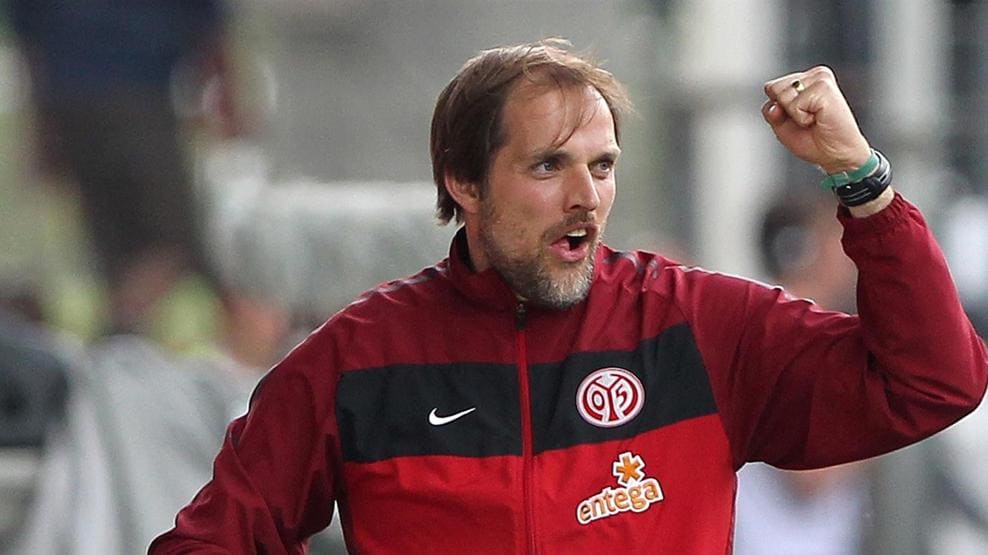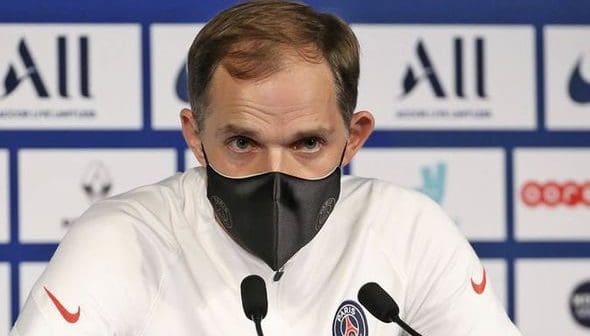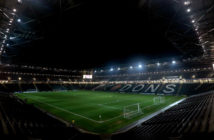Chelsea are set to replace Frank Lampard with German coach Thomas Tuchel in the next 48-hours following the club legends dismissal on Monday.
Frank Lampard’s position as Chelsea head coach has been on thin ice for quite some time.
Since beating Leeds United at the beginning of December, the Blues have won only two of their last eight Premier League matches, with the wins against West Ham United and Fulham far from convincing.
Despite Chelsea’s 3-1 win over Luton in the fourth round of the FA Cup on Sunday, the decision to part company with the club’s all-time leading goalscorer was inevitable after the 2-0 defeat away to Leicester City last Tuesday.
Having spent more than £200 million in the summer on Ben Chilwell, Kai Havertz, Timo Werner, Eduoard Mendy and Hakim Ziyech, a large part of Lampard’s job this season was to get the best out of his new signings — something he failed to do.
It is understood that the recent run of results and poor performances did not meet the hierarchy’s expectations leaving the club ninth-placed in the league table and “without any clear path to sustained improvement”.
Speculation of his sacking begun in early January after the west Londoner’s lost 2-0 against Manchester City at Stamford Bridge, and was followed by an unconvincing 1-0 win over Fulham, who were down to ten men for the whole of the second half.
In spite of defying expectations by securing a top-four finish during a transfer ban last season, all whilst integrating a number of youth players into the first eleven, Lampard leaves with a lower points total than this stage last season and with the lowest points per game ratio than any other Chelsea manager in the Roman Abramovich era.
The Russian oligarch is believed to have decided that former 47-year old Borrusia Dortmund and Paris Saint Germain coach Thomas Tuchel, a manager Chelsea were close to appointing in 2017 but opted for Antonio Conte instead, is the right man to replace him.
So who is Tuchel and how will he set up at Chelsea?
Tuchel: the man & the manager
Born in Krumbach, West Germany, Tuchel is far more known for his managerial career than his playing one.
Playing as a central defender for the likes of TSV Krumbach and FC Augsburg at youth level then Stuttgarter Kickers and SV Ulm as a senior, the German was forced to retire at the age of 25 following a serious knee cartilage injury in 1998.

Credit: Bundesliga
Two years after hanging up his boots, Tuchel returned to the professional game as youth team coach at VfB Stuttgart, aiding in the development of future first-team players, namely Mario Gómez and Holger Badstuber.
In 2005, he returned to Augsburg as the youth team co-ordinator before transitioning into management after being offered the position as first-team coach of the second team ahead of the 2007–08 season.
With Augsburg II, Tuchel coached a team that included Julian Nagelsmann – the now RB Leipzig coach who Chelsea have looked to appoint in recent weeks before siding with Tuchel – who also transitioned into coaching after an injury riddled playing career.
But his first major role was with newly-promoted and financially stricken Mainz in 2009 — replacing Jurgen Klopp — and established them as Bundesliga regulars, incorporating various young prospects in a high-pressing, attack-minded system.

Credit: Getty Images
He left the club in 2014 after a dispute over the lack of finances available to improve the squad and was hired by Dortmund a year later, again replacing Klopp.
During his two seasons at the Signal Iduna Park, Tuchel revitalised the team and guided the Black and Yellows to second and third-place finishes whilst winning the German Cup in his final campaign before being sacked.

Credit: The Telegraph
His two-year tenure as the first-team coach was again marred with controversy, with a strained relationship with the club’s hierarchy, notably CEO Hans-Joachim Watzke, over contrasting views regarding transfer dealings.
He then replaced Unai Emery as Paris Saint-Germain boss in May 2018, signing a two-year deal with the French giants.
Tuchel went on to win back-to-back titles with PSG, as well as two cups and guided them to the Champions League final in 2020 where they lost 1-0 to Bayern Munich.
Despite wielding the best win percentage in Ligue 1 history (75.6%) and the highest average of points per game (2.37, tied with his predecessor Emery), confirmation of Tuchel’s departure from PSG in December 2020 came as little surprise given his increasingly fractured relationship with the club’s hierarchy.

Credit: Reuters Photo
Tuchel’s tactics at Dortmund & PSG
Having been influenced by both Pep Guardiola and Klopp respectively, Tuchel is the perfect mix of positional play and the gegenpress.
In his two high-profile jobs, Tuchel was appointed to succeed two respected and successful managers by evolving and reinvigorating the strong teams he was inheriting.
At Dortmund, he retained Klopp’s 4-3-3 system which often became a 4-2-3-1 in play. Tuchel uses positional play principles to set up a strong team structure in which players have maximum passing options while also affording them the freedom to make their own decisions and express themselves on the ball – a philosophy often depressed under managers who also use positional play.
To achieve a good positional structure, Tuchel coached his Dortmund team to transition into a 2-3-5 or 3-2-5 shape when in possession.

Credit: The Coaches Voice
With the lengthier build-up play that comes with an increased emphasis on possession, his players at Dortmund had more time to rotate into different areas of the pitch – with the likes of Shinji Kagawa moving into the left half-space and Marco Reus moving into the right half-space allowing fullbacks Łukasz Piszczek and Marcel Schmelzer to push forward out wide.
Tuchel always wants his forwards to be linked in diagonal angles as it allows a more direct attacking approach and prevents horizontal passes. If a half-space player receives the ball, they can immediately pass it to a runner and maintain fluidity in attack.
Most of Tuchel’s formation changes are made to match the opponent when out of possession. A good example of this is Tuchel’s use of a dynamic front three, who forced long balls by closing down the opposing centre-halves and covering their passing lanes.
Furthermore, an improved grasp of possession meant that they often succeeded in restricting opponents to their defensive half.
Against settled opposition in which contributed to them regularly encountering lower blocks, Tuchel often deployed Pierre-Emerick Aubameyang as an outlet to receive long vertical ground passes to then lay off for a runner in the half-space.
Aubameyang’s link-up play wasn’t, and still isn’t, great but if he lost the ball it allowed Dortmund to counter-press and break forward.
Tuchel also experimented with the use of a back three as a more safe and cautious alternative to the 2-3-5 formation against tougher opposition as it gave them an extra man to defend against transitions.
In Paris, Tuchel similarly retained Emery’s 4-3-3 and 4-2-3-1. But like at Dortmund, he demanded rotations from those in central areas, encouraging Neymar, Kylian Mbappé and others to remain in narrower positions, closer to Edinson Cavani and then Mario Icardi, their central striker.
In possession, Tuchel kept a consistent 2-3-5 shape with the half-space players dropping deep to form diagonal angles. On paper, PSG actually set up in a 4-2-2-2 formation with his central midfielders covering the spaces that their full-backs had left, as well as when to withdraw into central defence and temporarily form a back three.
With Marquinhos often operating as a defensive midfielder alongside Marco Veratti in a double pivot, the Brazilians flexibility allowed PSG to switch to a 3-2-5 when needed – similarly to Piszczek, who moved centrally from right-back to provide cover.
Nonetheless, Tuchel favoured a back four as PSG progressed to the Champions League final last season.
They defended with either a 4-4-2 or 4-3-3, and attacked with a 2-3-5 in which Neymar and Angel Di María operated deeper as number tens in front of a double pivot and behind the explosive Mbappé.
Tuchel’s Chelsea – how will they set up?
While Lampard’s managerial philosophy still remains unclear, Tuchel’s could hardly be any clearer and his imminent appointment makes a lot of sense. His intense, high-pressing system suits the current crop of players and is just what the Blues need to get up and running again.
As seen at Dortmund and PSG respectively, Tuchel loves dynamic full-backs that can stretch the pitch and at Chelsea, he would have two of the best full-back pairings in Europe.
Although Chilwell is perfect for this role, Reece James is not as dynamic as his fellow countryman but with no current defensive midfielders at the club who like to form a back three, James could tuck in, like Piszczek, and provide defensive solidity.
In contrast, James could also push forward and invert into an inside eight, like Joao Cancelo at City this season, and push one midfielder up, such as Mason Mount, Ziyech or Havertz, to form the renowned front five.
This is tactic would not be foreign to the 21-year old right back either, having played as a defensive midfielder in Chelsea’s various youth setups.

Credit: The Premier League
For all the attacking talent Tuchel has had over the years, he has never had an out-and-out target man at his disposal and even brought Eric Maxim Choupo-Moting at PSG because his other strikers struggled to play between the lines.
At first glance, Oliver Giroud appears as the perfect player for this position with his world-class hold-up play and one-touch layoffs, yet Tuchel may prefer Tammy Abraham who is far more mobile like the Hungarian forward Adam Szalai, who thrived up-top for Tuchel at Mainz.

Credit: The Mastermind
If a target man is deployed, the system seen at Dortmund where the half-space players would drop deep while the striker and wingers push forward would be reversed at Chelsea. Instead, the striker would drop deep and the half-space players, like Werner and Havertz, would run in behind.
However, it is more than likely that Tuchel sticks to his tested methods and plays Werner as a central striker like he did with Aubameyang.
Again, this system would suit Chelsea to a T with the likes of Pulisic, who has already played under the Germans methods, and Callum Hudson-Odoi who are ideal at beating their man and working behind the oppositions full-backs.
Other clear comparisons can be made between Julian Weigl and İlkay Gündoğan, and Jorginho and Mateo Kovacic if Tuchel wishes to replicate a controlling and ball-carrying pivot pairing.

Credit: The Bundesliga
Or like at PSG where Tuchel deployed Marquinhos to prevent transitions next Verratti who created from deep; N’Golo Kante and Billy Gilmour could mirror this partnership.
The verdict
Tuchel, in earnest truth, would be a great fit for Chelsea and the German knows this too, with his agents pushing for the move.
Currently in Germany, Tuchel should arrive in the United Kingdom in the next 48 hours subject to a negative COVID-19 test.
He may have struggled to instil his philosophies in previous jobs with his willingness to control making him various enemies in the past, but Abramovich has long craved an offensive playing style that provides entertainment as well as results, whilst getting the best out of Werner and Havertz – a task that ultimately lost Lampard his job.
Follow us on Twitter @ProstInt
EPL
Apologies, but no results were found for the requested archive. Perhaps searching will help find a related post.Chelsea
Nothing Found
![Prost International [PINT]](https://prostinternational.com/wp-content/uploads/2021/08/PINTtFontLogoRoboto1536x78.jpg)



